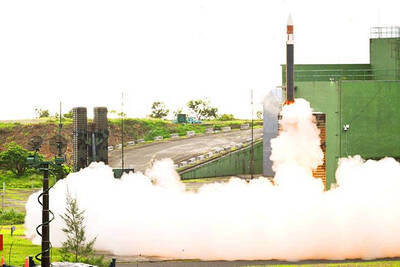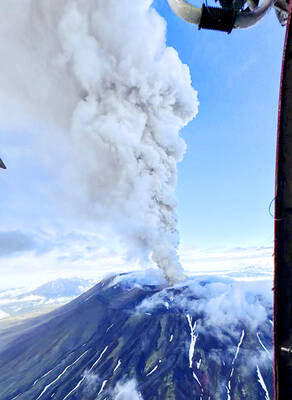Face wrapped in a thick scarf against clouds of blinding dust, the electrician gazed at a maze of pipes and pumps teeming with 15,000 workers and compared his work to building the Tower of Babel.
He was speaking casually. But for the oil industry Kashagan, the world’s biggest discovery since 1968 with reserves locked amid lethal, high-pressure gases beneath the north Caspian Sea, is a challenge of biblical proportions.
“There are people from 30 different countries working here,” said electrician Leonid, asking not to be identified because he was not authorized to speak to the media. “But we do try to find a common language.”

PHOTO: REUTERS
Kashagan, developed by oil majors including Eni and Exxon Mobil, represents all the challenges Western countries face to secure energy supplies as Asia becomes more energy-hungry and Russia seeks to dominate resources on its borders.
The field’s difficult geology, remote location, harsh climate and environmental challenges make it one of the world’s most complex and, at US$136 billion so far, expensive energy projects.
As state-owned companies now control most global reserves, Kashagan shows how Western majors that once dominated the industry now have to take what chances they can to produce oil.
With an estimated 9 billion barrels of recoverable oil, Kashagan is an almighty undertaking.
In temperature swings from minus 40ºC to plus 40ºC, the oil in the Kazakh field is heavy in sulphur — a hazard to health and the environment.
“It’s a project of immense difficulty,” said Eduard Poletayev, an independent analyst who closely watches Kashagan.
Due onstream in three years, Kashagan is one of a dwindling group of giant oilfields as cheaper and more accessible sources dry up. Only 11 such giant fields were found in the 1990s, down from 29 in the 1960s, investment bank Simmons & Co said.
“All the big oilfields have now been gobbled up and Kashagan is the last pearl in the crown of the world oil industry. That’s why oil companies are fighting for it so stubbornly,” Poletayev said.
Expected to produce the equivalent of 10 percent of Europe’s energy needs once at the height of its production, Kashagan can make Kazakhstan a new global source of non-OPEC energy.
It is at the heart of a tussle between Russia, China and Europe, reflecting the challenges faced by the West in maintaining its place as the market of choice for oil producers, and Europe’s battle to reduce its reliance on Russia for energy.
The main question is where the oil will go.
One option is to ship it by tanker across the Caspian Sea to the Baku-Tbilisi-Ceyhan oil pipeline that runs to Europe. BP leads that pipeline, but is not a partner in Kashagan.
Such a route is likely to irritate Russia: Moscow wants to boost its role as Europe’s leading energy supplier by persuading operators to feed the oil into a separate, Russia-bound line run by the Caspian Pipeline Consortium, for transit to Europe.
But the oil could also flow east to energy-hungry China, or — a more controversial possibility — to southern markets via Iran. No single operator holds a deciding majority.
The consortium’s media department in Kazakhstan said it could not comment on possible export routes.
“Kashagan isn’t producing any oil yet so they are being very careful,” Poletayev said. “Because otherwise it’s like selling the bear’s skin before the bear has been caught.”
An hour’s helicopter flight over the emerald green waters of the north Caspian reveals a field of magnificent proportion.
Forming the heart of drilling operations is a scattering of artificial islands encircled by huge man-made reefs designed to prevent shifting ice from destroying drilling rigs in winter.
Onshore, an oil processing facility the size of Washington DC is a swarm of construction activity. In stifling summer heat, that is where Leonid and hundreds of others work.
Once at full capacity, Kashagan will produce 1.5 million barrels of oil per day — enough to power Italy.
Three onshore tanks will contain 2 percent of global daily crude consumption. Electricity will be carried to the field via 6,000km of cable — roughly the distance between London and Kabul.
“This is where the oil will flow from,” said one Kashagan official, who, like most, spoke on condition of anonymity. Where it flows to is “for the politicians to decide.”
Further up the Caspian shore near Kashagan, people in the village of Dossor see no need for anonymity in discussing their experience of oil wealth.
“We have been producing oil for 100 years here,” said Bakhyt Smatullin, an official in charge of local oil production in Dossor, which is home to Kazakhstan’s oldest deposit.
“This village should be made of gold by now,” Smatullin said.
Oil was discovered by Swedish investors 100 years ago, but the village is a ramshackle collection of huts around a few creaking oil rigs. Herds of camels graze nearby.
Up to a quarter of the Kazakh population still lives in poverty despite the oil and metals wealth.
Kashagan became a source of particular tension in 2007 when the Kazakh government accused its operators of allowing costs to spiral and missing the original 2005 production start target.
The row unnerved investors and sparked concerns that the government could embark on a course of resource nationalism, potentially denying the multinationals access.
Adding to its complexity, Kashagan lies at the heart of a delicate ecosystem, home to many species unique only to these waters, such as the rare Caspian seal.
Local campaigners say thousands of dead baby seals have washed ashore since 2000, suggesting the deaths may be linked to oil drilling — a charge denied by Kashagan operators who say they are strongly committed to protecting the environment.
Sulphur is another point of contention. Yellow piles the size of several soccer fields produced elsewhere in Kazakhstan are a common concern.
Ecologists say biodiversity eroded when the Caspian Sea became the subject of mass industrial exploration in Soviet times.
“After the Soviet Union collapsed, all industrial activity stopped and nature became clean,” said Fyodor Sarayev, a local photographer who is documenting disappearing wildlife. “But now the steppe is empty again. The steppe is full of grass but there are no animals to eat it.”

Authorities have detained three former Taiwan Semiconductor Manufacturing Co (TMSC, 台積電) employees on suspicion of compromising classified technology used in making 2-nanometer chips, the Taiwan High Prosecutors’ Office said yesterday. Prosecutors are holding a former TSMC engineer surnamed Chen (陳) and two recently sacked TSMC engineers, including one person surnamed Wu (吳) in detention with restricted communication, following an investigation launched on July 25, a statement said. The announcement came a day after Nikkei Asia reported on the technology theft in an exclusive story, saying TSMC had fired two workers for contravening data rules on advanced chipmaking technology. Two-nanometer wafers are the most

NEW GEAR: On top of the new Tien Kung IV air defense missiles, the military is expected to place orders for a new combat vehicle next year for delivery in 2028 Mass production of Tien Kung IV (Sky Bow IV) missiles is expected to start next year, with plans to order 122 pods, the Ministry of National Defense’s (MND) latest list of regulated military material showed. The document said that the armed forces would obtain 46 pods of the air defense missiles next year and 76 pods the year after that. The Tien Kung IV is designed to intercept cruise missiles and ballistic missiles to an altitude of 70km, compared with the 60km maximum altitude achieved by the Missile Segment Enhancement variant of PAC-3 systems. A defense source said yesterday that the number of

A bipartisan group of US representatives have introduced a draft US-Taiwan Defense Innovation Partnership bill, aimed at accelerating defense technology collaboration between Taiwan and the US in response to ongoing aggression by the Chinese Communist Party (CCP). The bill was introduced by US representatives Zach Nunn and Jill Tokuda, with US House Select Committee on the Chinese Communist Party Chairman John Moolenaar and US Representative Ashley Hinson joining as original cosponsors, a news release issued by Tokuda’s office on Thursday said. The draft bill “directs the US Department of Defense to work directly with Taiwan’s Ministry of National Defense through their respective

Tsunami waves were possible in three areas of Kamchatka in Russia’s Far East, the Russian Ministry for Emergency Services said yesterday after a magnitude 7.0 earthquake hit the nearby Kuril Islands. “The expected wave heights are low, but you must still move away from the shore,” the ministry said on the Telegram messaging app, after the latest seismic activity in the area. However, the Pacific Tsunami Warning System in Hawaii said there was no tsunami warning after the quake. The Russian tsunami alert was later canceled. Overnight, the Krasheninnikov volcano in Kamchatka erupted for the first time in 600 years, Russia’s RIA